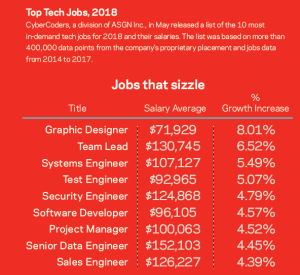It’s a sellers’ market in the IT recruiting space, with demand for workers with the right skills outpacing the supply.
Staffing Industry Analysts’ most recent staffing industry forecast cited supply constraints as the main impediment to revenue growth in the IT temporary staffing space, largely offsetting growing demand. Meanwhile, the TechServe Alliance described IT job growth in April as “anemic” in its monthly report, with lack of talent supply hindering job growth. And getting workers with the right skills can prompt some to take extreme or creative measures.
The former senior VP of people operations at Google, Laszlo Bock, in his 2015 book Work Rules!, recounted how the search giant took out a billboard advertisement on the 101 freeway in California’s Silicon Valley as part of a recruiting effort in 2004. The billboard didn’t mention Google, it only read “{first 10-digit prime found in consecutive digits of e}.com.” People who solved it would go to a website and be asked to solve another puzzle before landing on a recruiting page. Unfortunately, the effort resulted in no hires, Bock wrote. Those who solved the problems weren’t a fit for the company.
Billboard ads might seem extreme, but the need to find and deliver the right skills to clients is real for staffing firms and others fighting for tech talent.
“Companies are trying anything and everything that they can,” says Kevin Dee, chairman and founder of Eagle Professional Resources, a staffing provider based in Toronto. “There are a lot of things people are doing to be first to the right candidate.” These include investing in processes and technologies to find people as well as offshore recruiting.
Dee says there is generally a high level of demand for people with skills in the IT space, although what a staffing firm sees depends on its client base. Anecdotal evidence indicates Canada is not booming as much as the US, where last year’s tax cut law spurred a lot of investment at companies. Still, he hears of IT jobs going unfilled in both countries.
“We see a constant demand and it’s also a competitive space. … It’s hypercompetitive,” Dee says. “Nobody has a factory producing these people in great demand.”
The skills shortage didn’t happen overnight, but it appears to be getting worse.
Courting Coders
Approaching high-demand candidates can also be trickier in this day and age. On some online forums, IT specialists can become annoyed with recruiters. One person on StackExchange this year asked for suggestions to “… politely interrupt recruiters who keep coldcalling me during work hours?” A post from 2016 on Medium was titled “Why so many developers hate recruiters,” although author Quincy Larson noted not all recruiters were spammers; some could help you.
On the other hand, recruiters must venture to where the candidates are. They just have to go about it the right way. It’s about forming relationships with the candidates, says Marvin Daugherty, director of talent acquisition and military liaison at Strategic Staffing Solutions, or S3. You also can’t just stick with traditional job boards, you have to go to social hangouts such as GitHub and Reddit, he says. But you have to take the right approach.
“You can’t just march in there as a recruiter, because you’re going to be shut out pretty quick,” Daugherty says. Take the time to get to know people and talk to them, he advises. If you’re too aggressive, you will get kicked out and not welcomed back.
It’s also about going to events and getting referrals. To help get the Strategic Staffing Solutions name out, the company has even brought in a geofencing solution that can send an ad for the company to mobile devices within a certain area such as a trade show. “It’s very passive, but it’s a way to get out there when we can’t reach them otherwise,” he says. It’s also not always about recruiting; sometimes you have to focus on getting your company’s name noticed.
And recruiters need to keep communications personal. Don’t just send the same mass email to everybody — personalize it.
Lackluster Wage Growth
“We’re very clearly at the point that there’s limited supply,” says Albert Barsoumian, VP of consulting at Digital Intelligence Systems, or DISYS.
Demand for tech workers is also strong and likely to stay that way. The need for technology to drive progress is still spreading and more firms are seeing themselves as technology firms. For example, a financial company may reinvent itself as a tech firm that provides financial services. And even when a candidate with the right skills is found, that person has likely received multiple offers.
But, “unlike previous cycles, I’m not seeing rising pay rates even though the demand is outpacing the supply,” Barsoumian says. Instead, companies are looking to increase efficiency and automate manual processes where they can.
DISYS founded its Automation Center for Excellence, or ACE, two years ago to help companies determine what they can automate and ensure they are optimally deploying bots into their environments. And while finding ways to automate tasks instead of supply people may not seem in staffing’s purview, Barsoumian says it’s the company’s aim to serve clients’ needs. Research by Staffing Industry Analysts found that the median hourly wage for all US computer occupations grew 2.1% year over year as of the most recent data available, May 2016. That compares to a 2.4% increase for all wage and salary workers. Still, the median average hourly wage for computer occupations was $39.84, more than double the median for all workers. In a more recent report, SIA also reported that a sustained acceleration in bill rates was not being seen.
Going Abroad
While there may be a skills shortage in the US, hiring workers with the right skills from overseas has also become more difficult as the federal government has gotten tougher on H-1B visas — typically used to bring in highly skilled workers such as IT professionals. US Citizenship and Immigration Services released a policy memorandum in February upping documentation requirements for companies, such as staffing firms, that place workers at third-party worksites.
Still, demand to bring in talent from overseas exists. The US received more petitions for H-1B visas than available under an annual cap of 85,000 for the sixth year in a row this year. In total, the government received 190,098 requests for H-1B visas this year, although that is down from 199,000 in the previous year.
Canada is more open to bringing in workers from abroad, Dee says. But the concern is making sure it’s finding the people with the right skills. And he says he would like to see the staffing industry working more closely with the government to bring in those people.
Back to School
With the shortage of the right skills, coding boot camps and other training options have come on scene.
Trilogy Education Services partners with universities to offer coding boot camps. Most recently, it teamed up with the University of Washington, and the New York-based company in May announced a $50 million series B funding round. The company has partnered with 34 universities across North America.
 CEO Dan Sommer says the company also works with employers to determine the correct skills.
CEO Dan Sommer says the company also works with employers to determine the correct skills.
“The market for technical skills has never been brighter and the outlook is naturally brighter even now,” Sommer says. “Companies are realizing the world around them is really changing. … There’s a need for education as a workforce.”
Some students come from technical backgrounds while some do not. Sommer says one student was a 70-year-old businessperson while another was a 24-year-old fisherman.
The school program enables students to get IT training while keeping their current jobs.
Staffing firms are also trying to help workers develop skills.
DISYS’ Barsoumian says the company has a 12-month program to train people in the most up-to-date skills in order to increase the number of candidates in the supply pool. It’s focused more on people who already have some IT skills but want to retool and update their skills.
Strategic Staffing Solutions’ Daugherty says his company has a program to train veterans in IT. The first time the company did a boot camp, it included veterans and military spouses, and the program was a two-month Java developer course for an entry-level job. The plan was for workers to spend one year at a company and then be hired permanently or they would go on to another contingent position.
Daugherty also notes that former military tend to have a lot of skills, but sometimes veterans need information on how to describe those skills so that a civilian hiring manager can understand them. But helping former military get the right job is worth the time and effort. “You hire the character and train the skills when it comes to a veteran,” Daugherty says.
On the Horizon
It’s also likely that tech workers will find themselves at the forefront of new recruiting technologies coming online “simply because they have the greatest awareness of it already,” says Aravinda Rao Souza, VP of marketing communications at staffing software firm Bullhorn.
One example of a new technology is artificial intelligence, which could be a gamechanger when it comes to recruitment as it could eliminate a lot of basic, nonvalue-add tasks, Souza says. Already humans cannot tell the difference between speaking with AI and other humans. However, true AI is not common, she notes. Many of the chatbots on the market now are based on decision trees.
Blockchain is another technology that could bring change to the recruitment industry, especially when it comes to tracking qualifications. Although there’s not a use case at this time.
Whatever the recruiting scenario, it’s likely that demand for tech workers will continue.
“There’s going to be no slowdown in the demand for tech,” Eagle’s Dee says. The Internet of Things, AI and big data will fuel demand and impact everyone and every company. And that’s not to mention legacy systems with COBOL and mainframes.
“What are they going to do when the 60-year-old programmers decide to retire?”







